This easy Biscoff cake is flavored with Biscoff cookie crumbs and topped with a delightful Biscoff cream cheese frosting and Biscoff drizzle.
When Biscoff (the Lotus Biscoff cookies) and the Biscoff cookie butter spread landed here in New Zealand, I knew I had to try it out. And these speculoos cookies are now my favorite store-bought coffee-dunking cookie. And that spread...so very delicious! And oh-so-moreish!

Jump to:
- Lotus Biscoff Origin and History
- Why You Will Love This Biscoff Cake
- Ingredients
- Room Temperature Ingredients
- Weighing and Measuring Ingredients
- Reduced-Sugar Variation
- Step-By-Step Instructions
- Expert Tips for This Recipe
- Storage and Freezing
- Biscoff Cake FAQ
- Other Recipes You May Like
- Rate & Review!
- Recipe Card
- Pin For Later
- Comments
Lotus Biscoff Origin and History
The Lotus Biscoff speculoos cookie came about in Belgium, in 1932. In 1956 this deliciously spiced biscuit (or cookie for my American friends) was introduced into the food industry as a biscuit to be served with coffee. And I think this was a genius move. But the term "Biscoff" was first coined in 1986 as the combination of the words "biscuit" and "coffee".
The delicious spread came about in 2008 and is super tasty on a slice of toast, and even better in baked goods such as my Biscoff Brownies and Biscoff Blondies!
Why You Will Love This Biscoff Cake
- This super easy Biscoff tray bake cake comes together quite quickly. And is full of that delicious rich Lotus Biscoff Flavor.
- A tray bake or sheet cake is perfect for larger gatherings.
- Crushed Lotus biscuits flavor the sponge, and can be enhanced with a touch of ground cinnamon.
- The not-to-sweet cream cheese frosting is flavored with cookie butter spread.
- This delicious dessert is for all the cookie butter lovers out there.
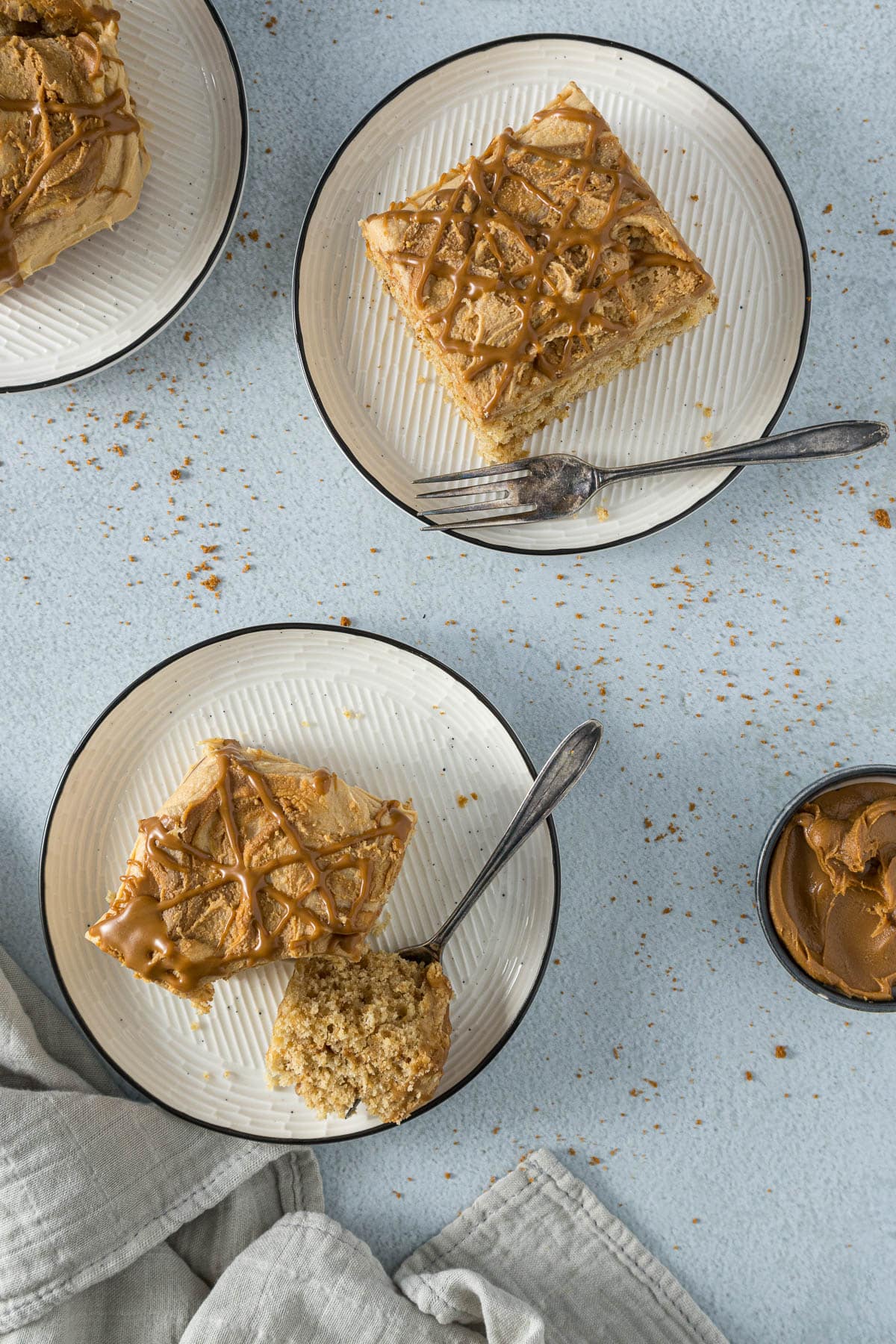
Ingredients
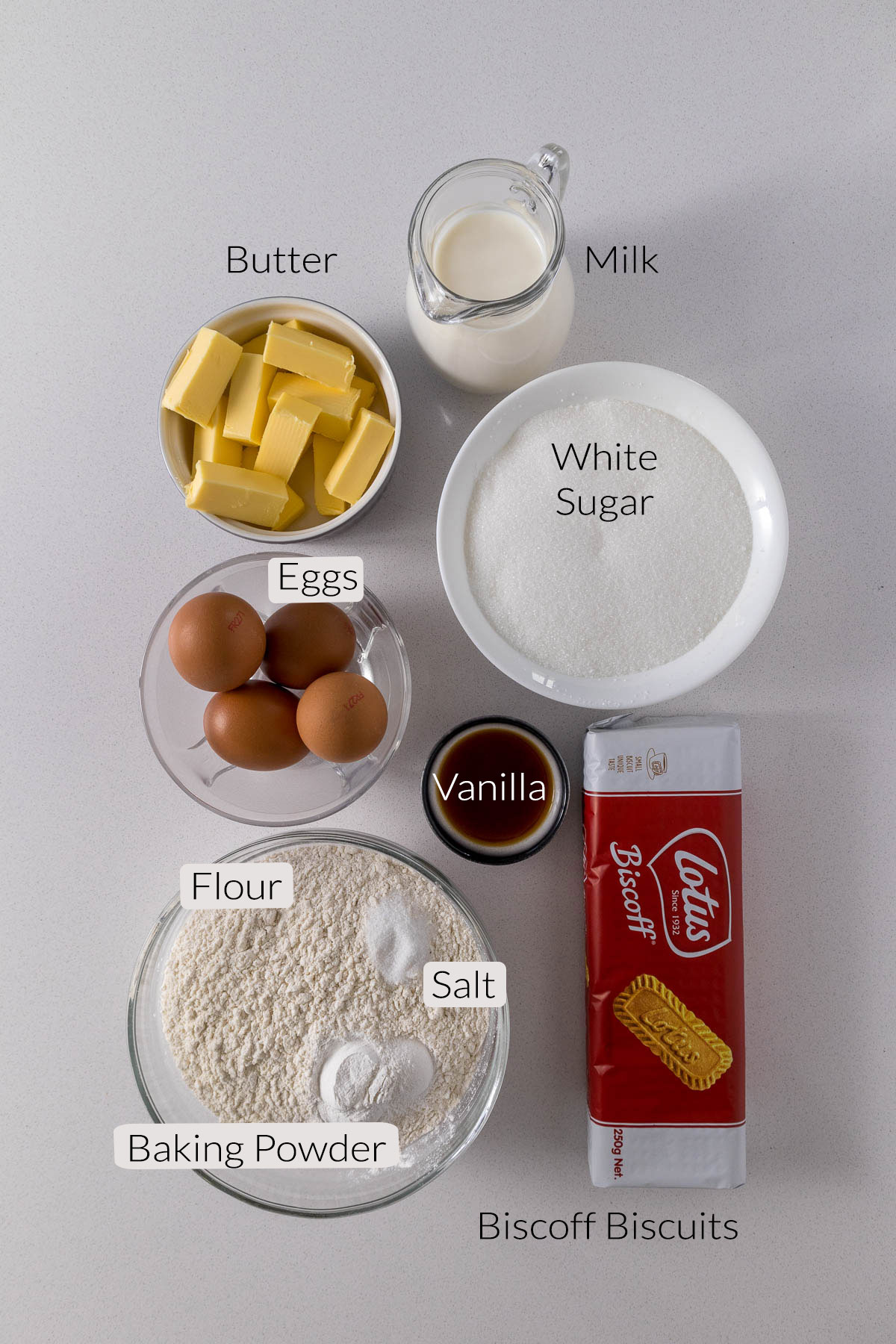
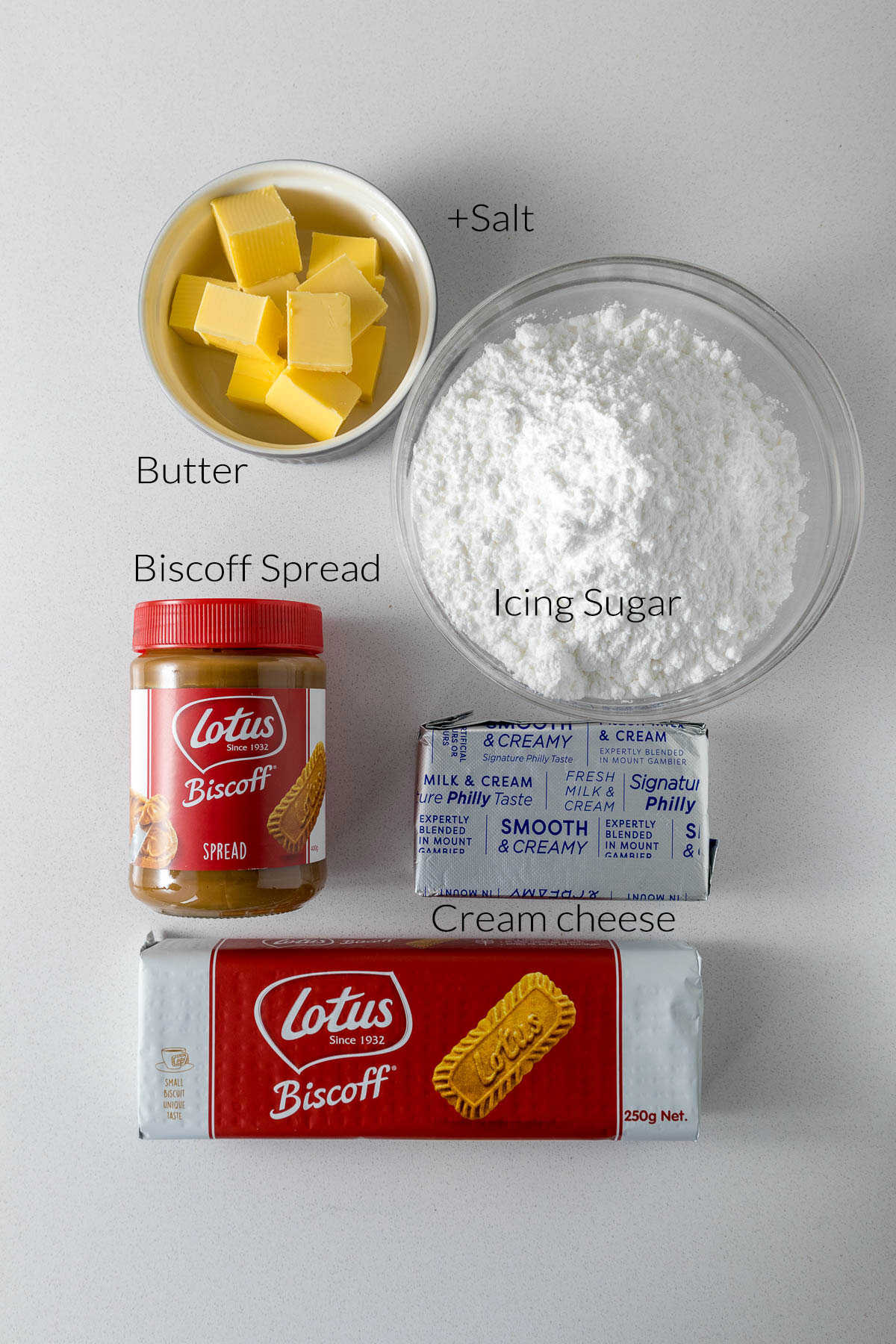
Butter adds flavor, softness, and moisture and sometimes aids in the leavening of baked goods. I use New Zealand butter in my recipes, which has approximately 82% butterfat and can be very yellow (similar to European or Irish butter). Butter cannot be substituted with butter or margarine spreads, but it can be substituted with baking margarine.
White sugar (granulated or caster sugar) adds sweetness without really impacting additional flavors in baked goods. Sugar doesn't only add sweetness, but it also enhances flavor, slows down gluten formation, and for this cake also acts as a leavening agent.
Vanilla extract enhances the flavors of the other ingredients in the recipe and is a cornerstone ingredient in baked goods and desserts containing eggs.
Ground cinnamon adds a bit more dimension to the cake, this is an optional extra.
Plain flour (all-purpose flour/standard grade flour) refers to flour that has a protein content of approximately 9.5-12%. I use standard-grade flour all almost all my baking.
Plain/all-purpose/standard grade flour can be substituted on a 1-to-1 basis for recipes that have ½ to 1 teaspoon of baking powder per 125 grams/1 cup of flour. For this cake recipe - a direct swap between flour and self-raising will work. Just remember to not add any extra baking powder.
Make sure your baking powder is fresh (especially if you haven't bought some in a while) by placing a ½ teaspoon into a cup or bowl. Pour about a ¼ cup of boiling water over the baking powder. If it foams and bubbles it is still fresh. Active baking powder is necessary for a good rise in baked goods.
Salt is a crucial ingredient in all baked goods. I use table salt in all my recipes. One teaspoon of table salt equals 1.5 teaspoons of Morton Kosher Salt equals 2 teaspoons of Diamond Crystal.
Lotus Biscoff biscuits are crushed and used to flavor the cake.
I use whole milk or full cream milk when baking. However, these can be substituted for lower-fate varieties. The best plant-based milk to use if needed is soy milk.
Eggs - I use a New Zealand size 6 egg, which is around the same size as Australian and South African Large Eggs, but closer to a US/Europe Medium sized egg.
Cream cheese - I always use Philadelphia cream cheese in the block form for all baking. And this is especially important when making cream cheese frosting.
Lotus Biscoff Spread is used to flavor the frosting or icing for this cake, as well as a used for a drizzle for a bit of decoration.
Icing sugar (powdered or confectioners' sugar) is a finely ground sugar that typically contains between 2 and 5% of starch (such as tapioca or corn). This is a quick-dissolving sugar that is used to make icing or frosting.
SM IMAGE
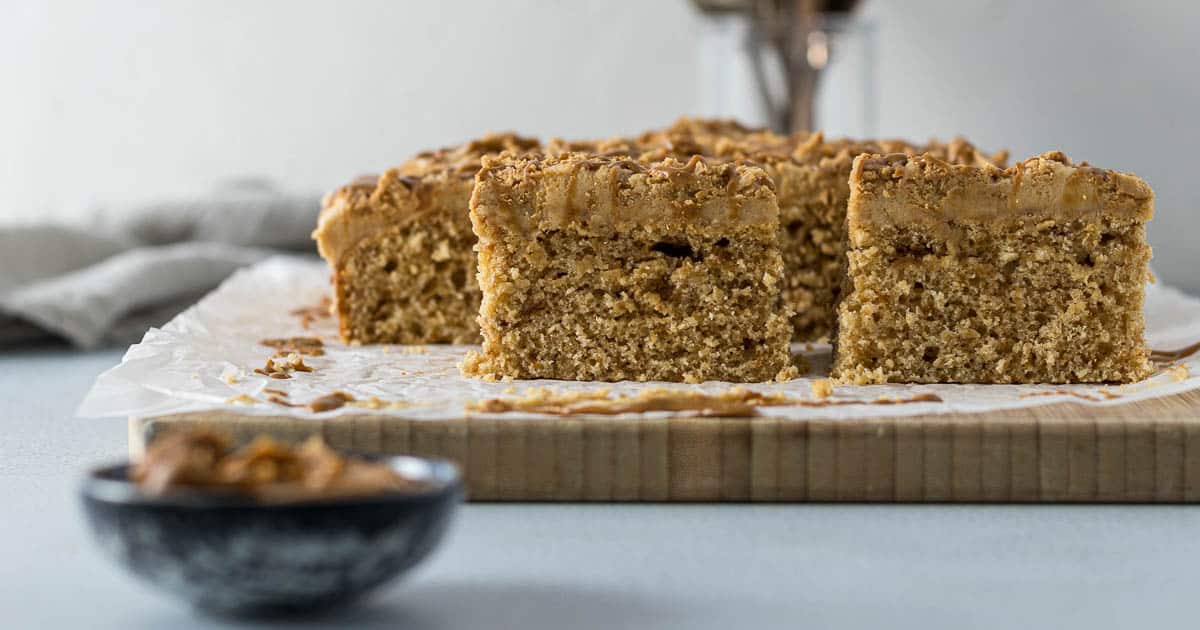
Room Temperature Ingredients
Use room-temperature ingredients! Using room temperature ingredients ensures that ingredients in the batter or dough will incorporate easier. Take note that room temperature refers to around 20°C/68F.
- To bring eggs to room temperature quickly, place them into warm water for about 10 to 15 minutes.
- To bring butter to room temperature quickly, cut the butter into cubes and zap it in the microwave at 20% power in 10-second intervals. Or place the cubes in a bowl over warm water (such as with a double boiler) over low heat for 1 minute!
- Milk, buttermilk, and cream can be brought to room temperature by zapping in the microwave at 20% power in 10-second intervals. Or on low heat for a minute or two swirling every 10-15 seconds.
- If the butter is too warm/soft for baking - pop it into the fridge for 20-30 minutes.
Weighing and Measuring Ingredients
Weighing ingredients with a kitchen scale is more accurate than using measuring cups. All my recipes are developed and tested using grams only.
However, I have activated the metric-to-cup conversions. Simply click on "USA/Cups" or "metric" for your preferred measurements. For these conversions, cups are equal to 240mL/8 fl oz, tablespoons are 15mL and teaspoons are 5mL.
Reduced-Sugar Variation
For the actual cake itself, I would not decrease the sugar content as this will alter the flavor and texture of the cake. The easiest way to decrease the sugar content is to decrease the amount of frosting on the cake and go with a thinner layer of icing sugar. Keep in mind that frosting can also be frozen for up to 3 months, so if you decided to use less frosting than you have made, simply pop it into an airtight container and freeze it for later use.
Step-By-Step Instructions
Lotus Biscoff Cake Recipe Instructions
1 - Preheat the oven to 180°C/350°F. Grease and line a 9x13-inch rectangular cake pan with parchment or baking paper.
2 - Crush or process the biscuits to form Biscoff cookie crumbs. Set them aside.
Note - the biscuits can be crushed by placing them in a ziplock bag and banging them with a rolling pin.
3 - Then whisk the flour, salt, ground cinnamon, and baking powder. This ensures the salt and baking powder are evenly distributed in the dry ingredients.
4 - In a large mixing bowl, or the bowl of a stand mixer (using a whisk attachment) beat the room-temperature eggs and white sugar together on a medium-high speed until light, fluffy, and almost meringue-like. This will take about 3-5 minutes.
5 - Add in the vanilla extract and mix through.
6 - With the mixer running on medium, slowly add in the cooled melted butter, and then the milk.

7 - Add half of the dry ingredients and mix until just combined (if using a mixer - use a low speed). Then add in the rest of the dry ingredients and mix until just combined.
8 - Add the crushed Lotus Biscoff cookies and fold into the cake batter.
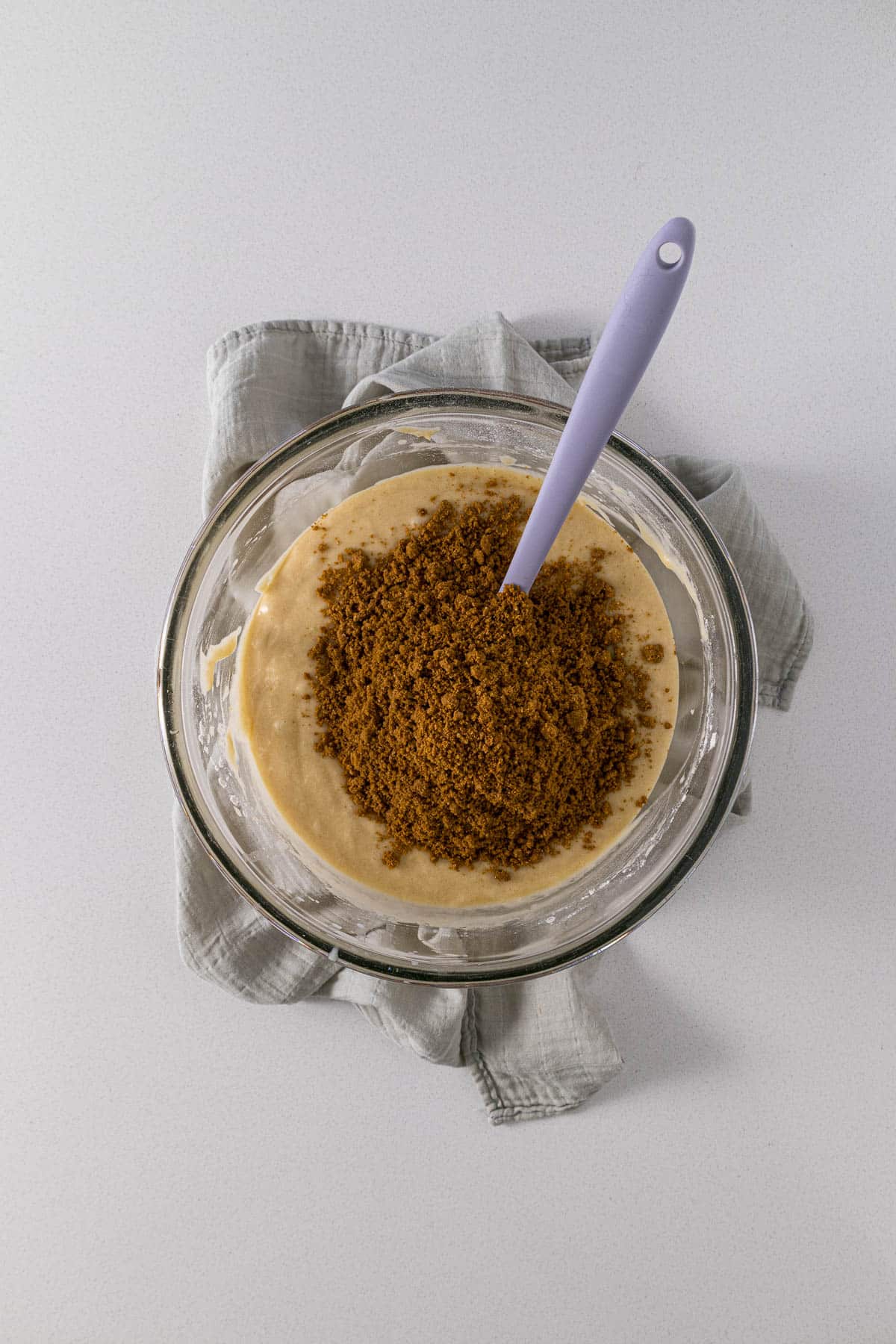
9 - Pour the cake batter into the prepared cake pan, smooth to the edges, and bake for 30-35 minutes or until a toothpick/cake tester comes out mostly clean from the center. Allow the cake to cool in the cake pan for 15-30 minutes before turning it out onto a wire rack to cool completely.
Biscoff Cream Cheese Frosting Instructions
Note - this makes about 3 cups of cookie butter frosting.
1- Place the butter and vanilla into a large mixing bowl and start beating with a whisk attachment on a low to medium speed for 2-3 minutes. Then increase the speed to high and beat for 3-5 minutes, scraping down the bowl in regular intervals to make sure all the butter is being beaten. The butter will become soft, fluffy, and almost white in color.
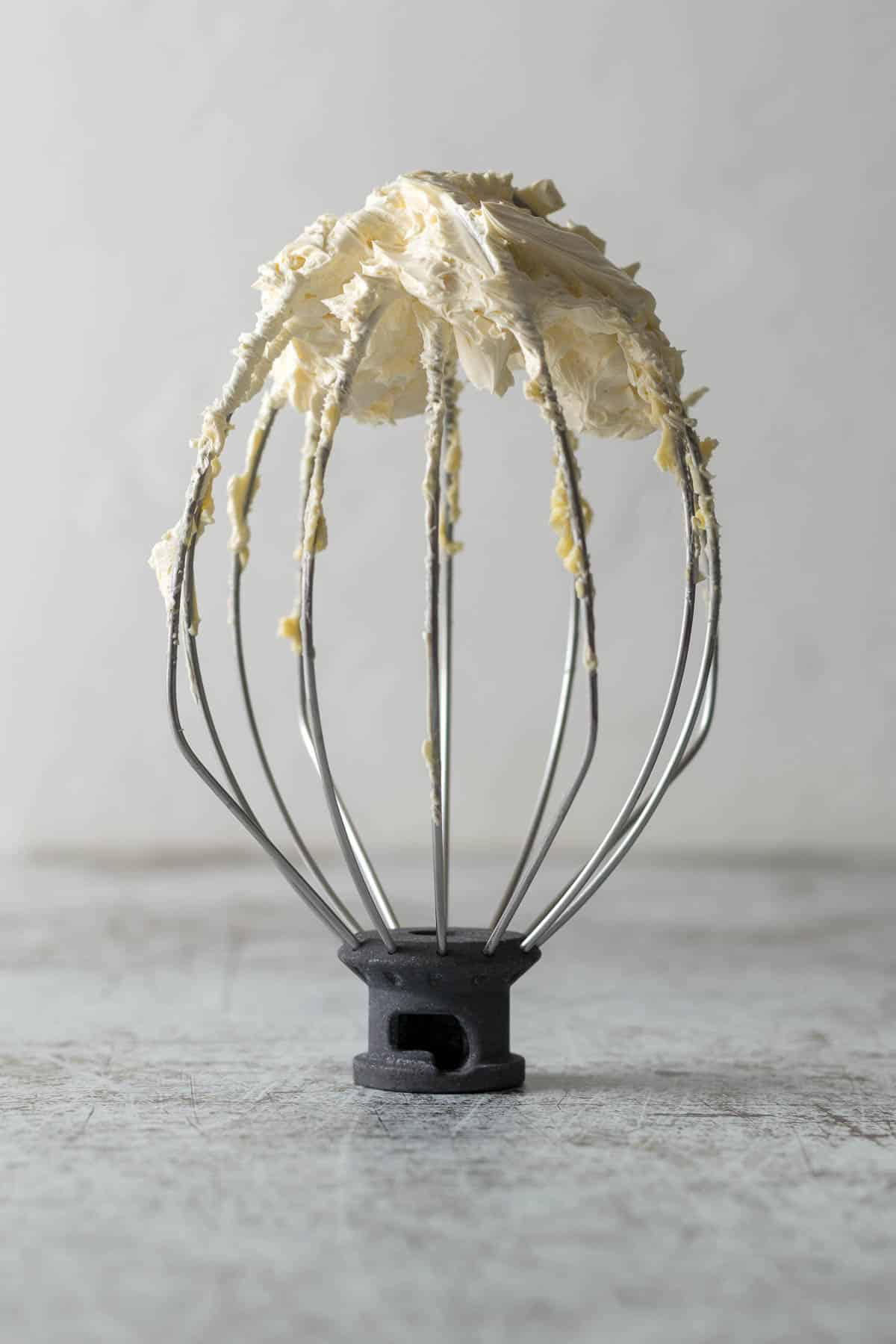
2 - Sieve the icing sugar over the butter, then add the salt. Using a paddle attachment, beat the icing sugar into the butter at a low speed. The mixture will look crumbly. Scrape down the sides of the bowl occasionally to make sure all the butter is being incorporated into the icing sugar.
3 - Add in the Biscoff spread and beat in until fully combined. Then add the cream cheese, and beat in on a low/medium speed with a paddle attachment until combined.
Cake Assembly Instructions
1 - Plop the frosting/icing over the top of the completely cooled cake, and smooth until mostly even using an offset spatula or the back of a dessert spoon. Then create swirly patterns on the top if desired.
2 - Melt the Biscoff spread in the microwave by placing it into a microwave/heat-proof bowl and heating it in 10-second intervals. Drizzle the spread over the top of the cake and allow it to set before slicing and serving.
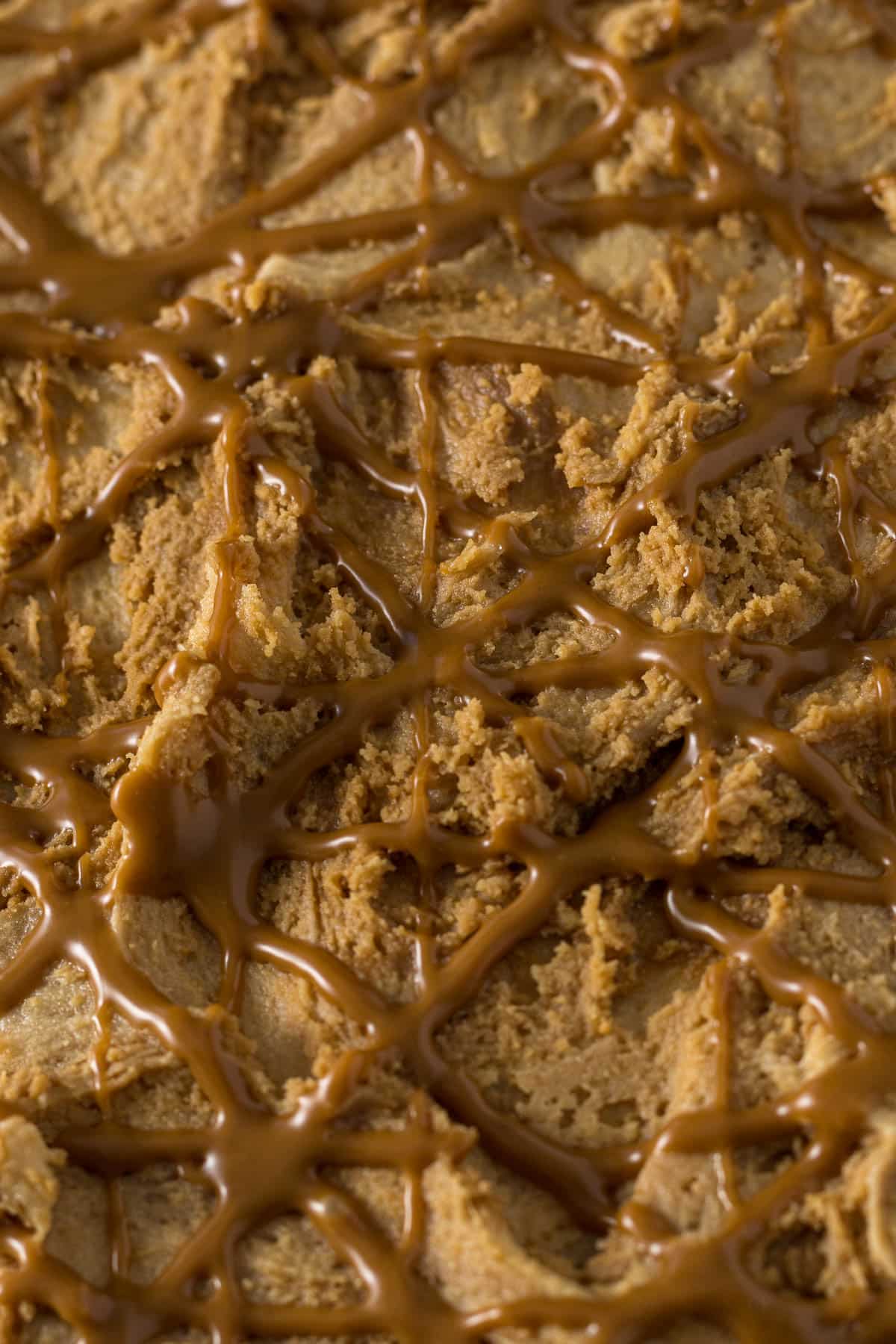
Expert Tips for This Recipe
Room temperature ingredients are important for both the cake and the Biscoff cream cheese frosting. When it is really nippy, I like to also warm my bowls and paddle or whisk attachments before use (usually by placing in the sun for a few minutes).
Baking Flat Even Layers
To ensure you get layers or a sheet cake as flat as possible, check the following:
- The oven temperature. An oven that is too hot will result in domed cakes. Use an oven thermometer to make sure your oven is at the right temperature.
- Grease the sides of the cake tin. This allows the batter to rise up the sides without gripping the sides.
- Use baking strips! Use damp cake pan baking strips to keep the sides of the cake tin cooler during the baking. This allows the side to rise at a similar rate to the center of the cake. Alternatively (the method I use) is to fold a piece of foil 4-to 5 times to create a strip (shiny side out) and wrap it around the outside of the tin. This is especially important for darker cake tins.
- Trimming the cakes is the last step in making flat layers. This can be done with a large serrated knife or wired cake leveler.
NOTE - the cake pans I used to bake this cake are rather dark, so I did wrap the cake pan in foil so that I would have a fairly even cake.
Ovens and Air-Fryers
The temperatures stated are for conventional ovens. For convection, fan-forced, fan-assisted, or air-fryers, the temperature must be reduced by 20°C/25°F.
For baking, make sure the oven is fully preheated, and that the rack is in the middle of the oven. Open the oven as little as possible. For best baking results use an oven thermometer.
Remember that all ovens work slightly differently and bake times may need to be adjusted for your specific oven.
Storage and Freezing
This cake, due to its cream-cheese frosting, should be stored in an airtight container in a fridge for up to a week.
Baked, unfrosted cakes can be wrapped in plastic wrap (cling film) and frozen for up to 3 months. Make sure the cakes are fully cooled before wrapping them.
Slices of cake can be frozen in an airtight container for up to 3 months. To prevent freezer burn, wrap the slices in plastic wrap before freezing. When defrosting or thawing the slices, remove the plastic wrap before it completely defrosts to ensure the frosting does not stick to the plastic wrap.
Biscoff Cake FAQ
Yes. This recipe will make about 18 cupcakes. Place about ¼ cup of batter per cupcake liner and bake in a preheated oven for 18-22 minutes or until a cake tester comes out mostly clean from the center of the cupcakes.
If you need to make this cake ahead of time, I would recommend making the tray cake/sheet cake and wrapping it in cling-film and foil, and freeze for up to 3 months before an event. Then I would make the frosting a day a two ahead, and store it in the fridge in an airtight container until
Other Recipes You May Like
Rate & Review!
If you made this recipe, please leave a star rating! It gives my readers and me helpful feedback. If you want more recipes, subscribe to my newsletter, and follow me on Instagram, Pinterest, and Facebook!
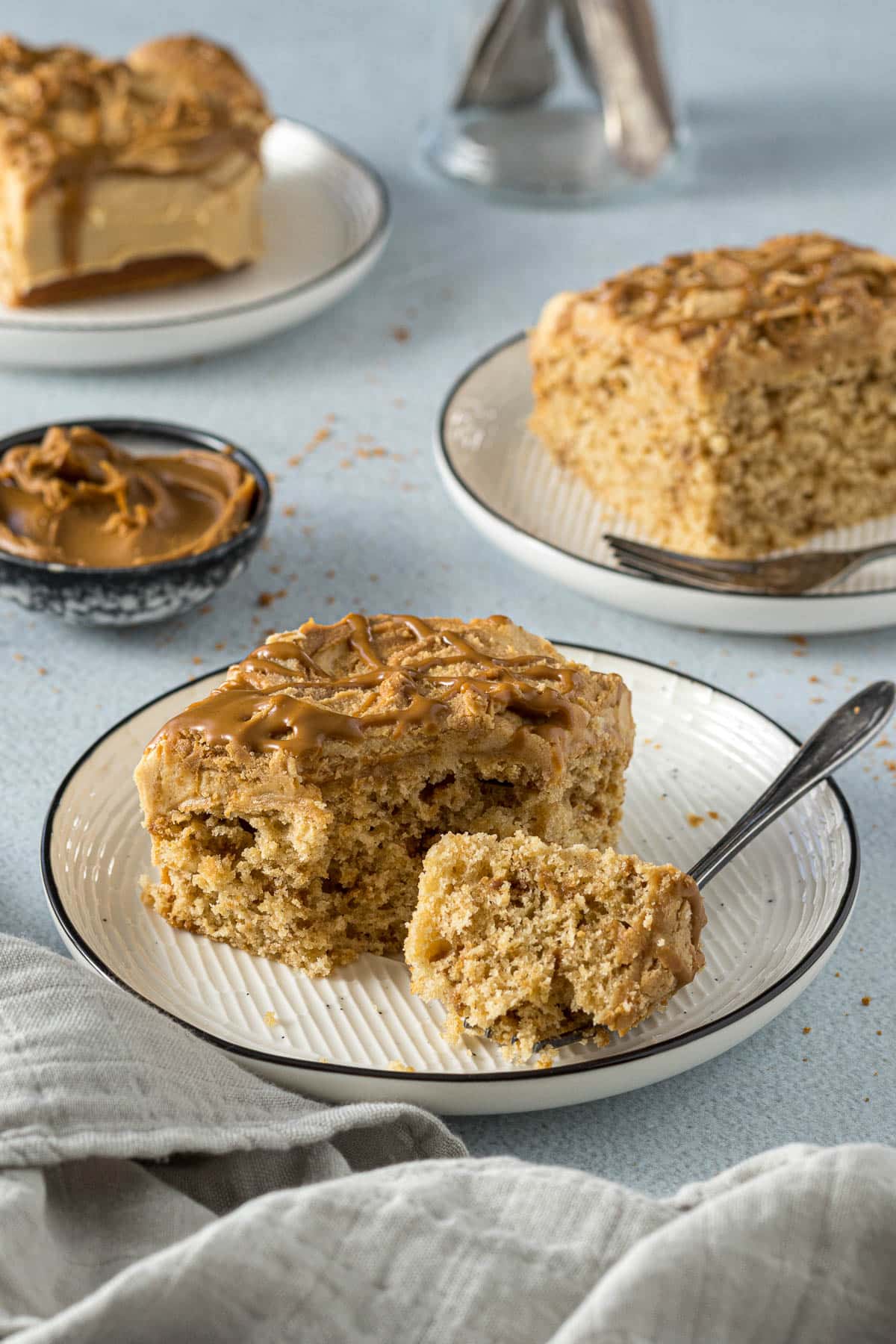
Recipe Card
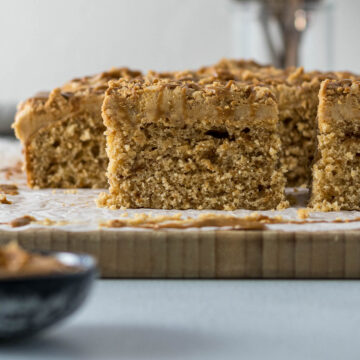
Easy Biscoff Cake
Equipment
- Rectangular Cake Pan (13x9 Inch/33cmx23cm)
- Stand Mixer OR
- Electric hand mixer
Ingredients
Biscoff Sponge
- 24 Lotus Biscoff Biscuits
- 3 cups plain flour (standard grade/all-purpose flour)
- 3 teaspoons baking powder
- ½ teaspoon table salt
- 1 teaspoon ground cinnamon (optional)
- ½ cup butter (*note 1 - 1 stick plus 2 tbsp)
- 4 eggs (Size 6/Med/large*note 2)
- 1½ cups white granulated sugar
- 3 teaspoon vanilla extract
- 1 cup milk
Biscoff Cream Cheese Frosting
- 1 stick butter (*note 3)
- 3 cups icing sugar (powdered or confectioner's sugar)
- ¼ teaspoon table salt
- ½ cup Biscoff spread
- ¾ cup cream cheese (*note 4)
Cookie Butter Drizzle
- ⅓ cup Biscoff spread (melted for drizzle)
Instructions
Lotus Biscoff Cake
- Preheat the oven to 180°C/350°F. Grease and line a 9x13-inch rectangular cake pan with parchment or baking paper.
- Crush or process the biscuits to form Biscoff cookie crumbs. Set them aside. *Note 524 Lotus Biscoff Biscuits
- Then whisk the flour, salt, ground cinnamon, and baking powder. This ensures the salt and baking powder are evenly distributed in the dry ingredients.3 cups plain flour, 3 teaspoons baking powder, ½ teaspoon table salt, 1 teaspoon ground cinnamon
- In a large mixing bowl, or the bowl of a stand mixer (using a whisk attachment) beat the room-temperature eggs and white sugar together on a medium-high speed until light, fluffy, and almost meringue-like. This will take about 3-5 minutes.4 eggs, 1½ cups white granulated sugar
- Add in the vanilla extract and mix through.3 teaspoon vanilla extract
- With the mixer running on medium, slowly add in the cooled melted butter, and then the milk.½ cup butter, 1 cup milk
- Add half of the dry ingredients and mix until just combined (if using a mixer - use a low speed). Then add in the rest of the dry ingredients and mix until just combined.
- Add the crushed Lotus Biscoff cookies and fold into the cake batter.
- Pour the cake batter into the prepared cake pan, smooth to the edges, and bake for 30-35 minutes or until a toothpick/cake tester comes out mostly clean from the center. Allow the cake to cool in the cake pan for 15-30 minutes before turning it out onto a wire rack to cool completely.
Biscoff Cream Cheese Frosting *Note 6
- Place the butter and vanilla into a large mixing bowl and start beating with a whisk attachment on a low to medium speed for 2-3 minutes. Then increase the speed to high and beat for 3-5 minutes, scraping down the bowl in regular intervals to make sure all the butter is being beaten. The butter will become soft, fluffy, and almost white in color.1 stick butter
- Sieve the icing sugar over the butter, then add the salt. Using a paddle attachment, beat the icing sugar into the butter at a low speed. The mixture will look crumbly. Scrape down the sides of the bowl occasionally to make sure all the butter is being incorporated into the icing sugar.3 cups icing sugar, ¼ teaspoon table salt
- Add in the Biscoff spread and beat in until fully combined. Then add the cream cheese, and beat in on a low/medium speed with a paddle attachment until combined.½ cup Biscoff spread, ¾ cup cream cheese
Assembly
- Plop the frosting/icing over the top of the completely cooled cake, and smooth until mostly even using an offset spatula or the back of a dessert spoon. Then create swirly patterns on the top if desired.
- Melt the Biscoff spread in the microwave by placing it into a microwave/heat-proof bowl and heating it in 10-second intervals. Drizzle the spread over the top of the cake and allow it to set before slicing and serving.⅓ cup Biscoff spread
Notes
- 125 grams of butter is equal to 1 stick plus 2 tablespoons but is equal to ½ cup in the UK, Aus, NZ, and South Africa.
- New Zealand size 6 eggs are around the same size as an Australian/South African Large or a US/Europe Medium.
- 113 grams is 2 tablespoon less than a metric cup and is equal to a stick of butter.
- I always use Philadephia block cream cheese.
- The biscuits can be crushed by placing them in a ziplock bag and banging them with a rolling pin.
- This makes about 3 cups of frosting, which is enough to frost 18 cupcakes.
Storage and Freezing
This cake, due to its cream-cheese frosting, should be stored in an airtight container in a fridge for up to a week. Baked, unfrosted cakes can be wrapped in plastic wrap (cling film) and frozen for up to 3 months. Make sure the cakes are fully cooled before wrapping them. Slices of cake can be frozen in an airtight container for up to 3 months. To prevent freezer burn, wrap the slices in plastic wrap before freezing. When defrosting or thawing the slices, remove the plastic wrap before it completely defrosts to ensure the frosting does not stick to the plastic wrap.Nutrition
Nutrition information is an estimate. If scaling the recipe remember to scale your cook and bakeware accordingly. All temperatures stated are conventional, unless otherwise stated. Recipes tested in grams and at sea level.
Pin For Later
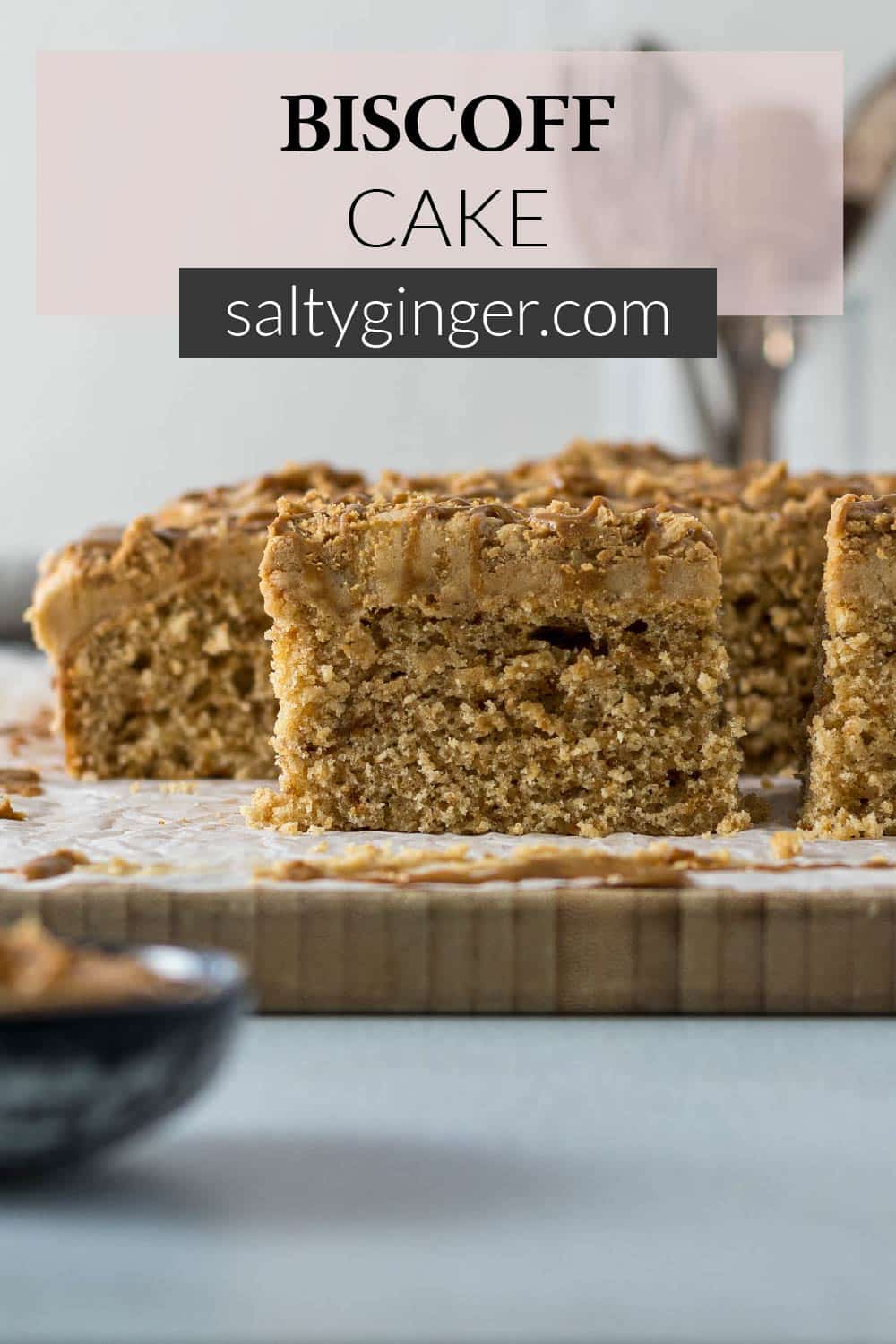

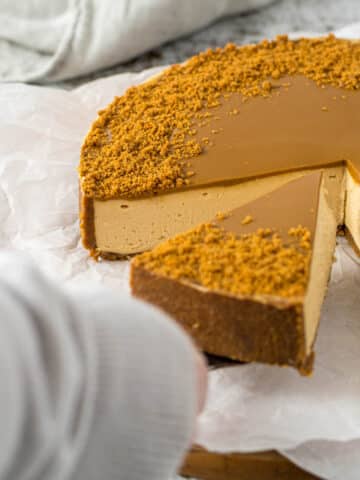
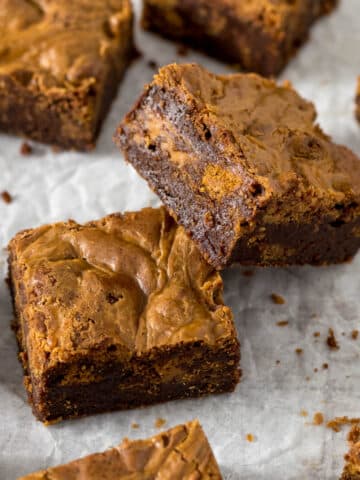
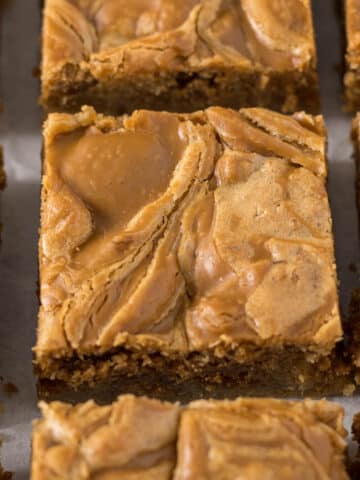
Comments
No Comments